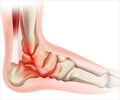Symptoms, Causes and Risk Factors of Sprained Ankle
Signs and symptoms of a sprained ankle involve pain, tenderness, swelling and an inability to walk.
Signs and symptoms of a sprained ankle depend on the degree of sprain and include the following:
- Pain, especially while exerting weight on the affected foot
- Swelling immediately after injury
- Tenderness at site of injury
- Bruising
- “Pop” sound at time of injury
- Restricted range of motion
If you experience pain and swelling in your ankle, you may have developed a sprain. Sometimes, self-care measure is all you may need, but you may need to get your foot evaluated and confirm the absence of fracture. The more the pain in your ankle, the greater will be the time it takes to heal.
When a sprain occurs, blood flow to the site of injury will increase, and white blood cells will start migrating to the affected area causing inflammation which is characterized by warmth, redness and swelling. The nerves too become greatly sensitive at the sprain site, causing throbbing pain. All this together makes it difficult to move the affected leg and walking becomes an impossible task.
Complications
If you continue with your daily activities without treating an ankle sprain, you will develop the following complications -
- Chronic pain in the ankle
- Chronic joint instability in the ankle
- Early-onset arthritis in the affected ankle joint
Sprained Ankle Causes Risk Factors
Sports or activities that involve energetic side-to-side motion or even daily activities can increase risk for ankle sprains.
Movements involving twisting, turning, and rolling of the foot are the chief causes of ankle sprain. These occur -
- During a fall resulting in ankle twist
- While landing on your foot awkwardly after jumping
- While walking or exercising on an uneven surface
Ankle sprains occur when you make a shifting movement with a foot after landing, causing the ankle to turn outward and the foot inward. This results in a damage to a ligament outside the ankle and is a common occurrence in playgrounds and open fields.
Sports or activities that involve energetic side-to-side motion, such as badminton, tennis or basketball and daily activities such as stepping off a side walk or slipping on ice can also increase risk for ankle sprain.
Risk factors for ankle sprain -
- Sports participation is a common risk factor for ankle sprains. Sports such as basketball, football and tennis that require you to roll or twist your foot, increase your risk for ankle sprains. This is more so if you are overweight or if you are playing or practising on an uneven surface.
- Prior ankle injury increases your chances of acquiring sprains in your ankle again
- Weak muscles / tendons across the ankle joint
- Weak ligaments that join bones of the ankle joint. This may either be hereditary or it can occur due to overstretching from repetitive ankle sprains
- Slow neuro - muscular response during off -balance to on-balance position
- Shoes with inadequate heel support and high-heeled shoes







